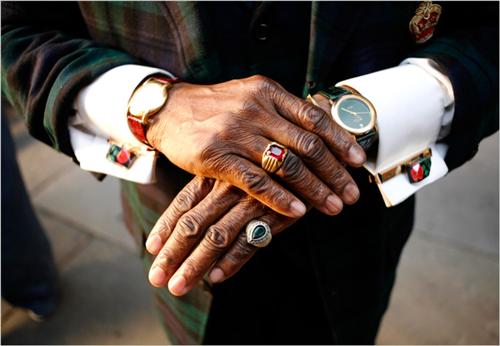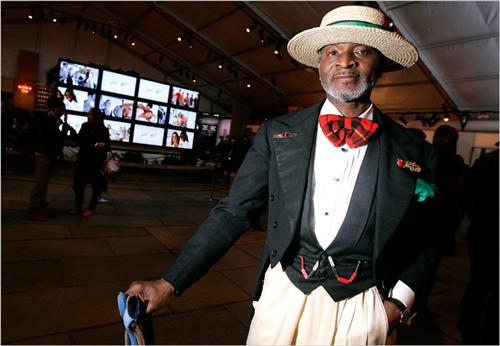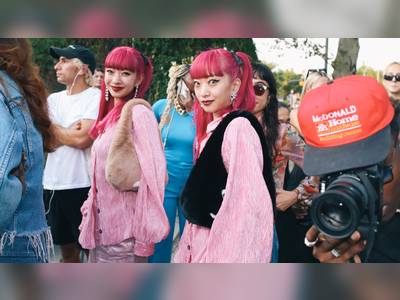
Extra-wide cuffs and a watch for each wrist were among the components of Mr. Boiz’s unique personal style on a recent day.
Mr. McDonald didn’t actually know Prince Williams by name, or for that matter, by profession, just by the sight of that hat and those suits and the painted cane he usually carries with him.
“Everyone in my family has this cane,” said Prince Williams, seated near the coffee stand just inside the main tent, a small Evian bottle at his side. He has a gentle foreign accent, a neatly trimmed graying beard and appealingly misaligned front teeth.
To those who stop to chat with Prince Williams, out of curiosity, or admiration for his style, the narrative is always the same: The cane comes from the Ivory Coast, where his father was born, the son of an African king. His love of fashion came from his father, a diplomat in Paris who impressed upon his son the importance of making an elegant first impression. Age 50-something, he’s a longtime designer for private customers, now working on his first collection.
Prince Williams’s business card names him as Bill Boiz, and has a ’30s-style illustration of a man in coat and tails; the business, it reads, is located in Suite 329 at an address in Times Square.
Mr. Boiz sticks mostly to men’s fashion; it’s a mission. “Men today are getting too sloppy,” he said. “I want to bring them back into shape.” His main inspiration is Moschino, “because of the attention to detail,” he says.
Since Mr. Boiz is reluctant to name any of his clients, and he has no Web site, his work life has an amorphous quality. Many of the regulars at the tent, like Mr. McDonald, knew of Mr. Boiz, but knew nothing about his work. “I think he’s one of those fashion bon vivants, a guy with a lot of money who just kind of loves fashion,” said one publicist.
A young stylist with a purple feather boa and an Afro that extended at least a foot in every direction declared him “a freak, in a good way — he probably hung out with Andy and Basquiat when they were young.”

Prince Williams, a k a William Boiz, is a regular feature at Fashion Week, known by sight, if not by name, to many of the fashion world’s denizens. He has also been photographed at designer shows in Paris, to the puzzlement of some fashion bloggers.
Sitting next to Mr. Boiz was the stylist Rosemary Ponzo, dressed in an abundance of black ostrich tail feathers, another character at the shows who’s a familiar face but whose work life is somewhat mysterious to regulars. Red lipsticked, smelling strongly of talc, showing off a swollen, sneakered foot, she proclaimed herself “the queen of fashion, and Mr. Boiz the prince.” Ms. Ponzo is occasionally found in the first row of designer’s shows, and Mr. Boiz usually finds his way to a good seat, despite a lack of any firm credentials other than appearances in style columns and blogs. He’s been photographed at the shows in Paris as well, a detail mystifying to fashion bloggers less admiring of Mr. Boiz, one of whom includes him among the “D-list stylists” who hang around the tents.
For the most part, at the shows, a strong personal style, whatever the experts’ verdict, is credential enough. It’s a place where editors in chief of far-flung editions of Vogue may find themselves seated behind Mr. Boiz, a man with indulgent acquaintances but hard-to-identify bona fides. A closer look at Mr. Boiz’s ensemble reveals a polyester, not silk, red handkerchief in his suit pocket. But the overall, if superficial, impression is one of elegance. People like Ms. Ponzo and Mr. Boiz “provide background color,” said Fern Mallis, the IMG senior vice president who presides over Fashion Week. “They do interviews; they’re like a breed of fashion ambassadors from their own world.”
A stroll of no more than four blocks takes a walker to Mr. Boiz’s other world, the address listed on his business card. That short passage leads to a building with a fine awning and a lobby with a small grand piano. On either side, there are staircases sweeping up to the second floor balcony. But the light is institutional bright, and the man at the desk identified himself as a “security official” rather than a doorman; asked about the building, he handed over a flier with information about federal housing assistance. Upstairs, a woman complained loudly about some lost food stamps.
The first tenant in Mr. Boiz’s building who walked up to the desk was dressed in a plastic gladiator helmet, wraparound sunglasses, a maroon graduation gown and a black backpack. Surely, he didn’t just come from the shows? “No, actually, I’m a panhandler,” he said. “This is just my personal style.”
Maybe if he lost the backpack and showed up at the Fashion Week tents often enough, giving thoughtful, affectionate interviews to foreign camera crews desperate for color, he, too, could have become a regular among a crowd dressed in oversize buttons and Dr. Seuss-inspired conical caps and very short shorts and doll-like petticoats. For all the air of exclusivity that emanates from the tents to the outsider, inside is a world surprisingly — or maybe not surprisingly — tolerant of eccentrics and the mysterious fantasies they live out. It’s the fashion world’s business to encourage both.
Reached at his studio in that building later that evening, Mr. Boiz was still elated by the Temperley London show he’d just attended by invitation. “It was very ’60s, but in a good way,” he said. Even if he hadn’t liked it, though, he would have held his peace. “I never criticize other fashion designers,” he said. “The work is too hard. Besides, all of us designers, we are like a family.”













